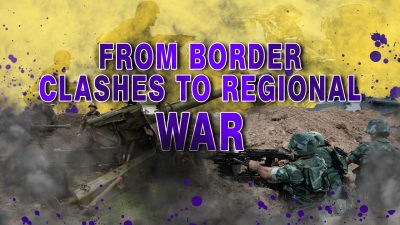Video: Armenia -Azerbaijan Clashes, Shifting Balance of Power in South Caucasus

The Armenian-Azerbaijani tensions have once again turned South Caucasus into a hot point increasing chances of a new regional war.
The key difference with previous military incidents between the two countries is that the point of confrontation shifted from the breakaway Nagorno-Karabakh Republic to the Armenian-Azerbaijani state border. Clashes first erupted on July 12 in the area of Tovuz and since then both sides have repeatedly accused each other of provoking the conflict, attacking civilians and declared defeats of the ‘enemy’.
According to the Defense Ministry of Azerbaijan, the fighting started after Armenian forces opened fire on positions of Azerbaijani forces in the Tovuz district. The fighting which included the use of combat drones, artillery, mortars, and battle tanks continued over the following days, including July 17. The Azerbaijani military confirmed that at least 12 personnel, including Major General Gashimov Polad and Colonel Ilgar Mirzaev, were killed. In turn, Kerim Veliyev, Azerbaijan’s deputy defense minister, said that 100 Armenian soldiers were killed, several fortified positions were destroyed and that a UAV was shot down. Armenia, according to Veliyev, is hiding the real number of its casualties.
Azerbaijani media and top leadership describe the current situation as an act of Armenian aggression, and say that Azerbaijani forces are only responding to it. President Ilham Aliyev even called Armenia a “fascist state” adding that “Armenian forces could not enter Azerbaijan in one centimeter of soil and will never be able to do this”.
The Armenian version of events is quite different. According to it, the clashes started after a group of Azerbaijani soldiers violated the Armenian state border in an UAZ vehicle. The defense ministry press service claimed that after the warning from the Armenian side, “the enemy troops returned to their positions”. It added that later Azerbaijani forces attacked an Armenian checkpoint.
As of now, the Armenian military said that it had repelled two ‘offensives’ involving at least 100 soldiers supported by fire of several artillery battalions. These attacks were allegedly actively supported by combat and reconnaissance drones of Azerbaijan. A spokesperson for the Armenian Defense Ministry Artsrun Hovhannisyan said that Azerbaijan lost at least 20 soldiers, a battle tank and other equipment during the clashes. Armenia says that only 4 of its service members were killed.
Both Armenia and Azerbaijan claim that their forces are repelling an aggression of the enemy, which has been attacking it and killing civilians. However, despite the harsh rhetoric, the leadership of the both countries are sending signals that they are not interested in a larger military confrontation.
At the same time, years of war propaganda and historic tensions between the nations push the situation towards a further escalation. A unilateral move towards the cessation of hostilities by leaders of either country would be presented by the other one as a sign of weakness and promoted as an admission of defeat. Taking into account the complicated political and economic conditions in both countries, neither Armenian nor Azerbaijani leaders could afford such a public move. Therefore, de-escalation is possible only through international mechanisms.
The situation is further complicated by the complex diplomatic situation in the region of the South Caucasus. Armenia, alongside with Russia, Belarus, Kazakhstan, Tajikistan and Kyrgyzstan, is a member of the Collective Security Treaty Organization (CSTO). The CSTO expressed its concerns over the situation and called on the sides to commit to a ceasefire regime. Nonetheless, the Russia-led security bloc, and Russia itself, demonstrated that in the current situation they will focus on diplomatic measures.
Since the 2018 coup, when Nikol Pashinyan came to power in Armenia, the country has been consistently undermining its relations with the CSTO and Russia by persuing a quite weak, but apparent anti-Russian and pro-Western foreign policy course. The bright dream of the Pashinyan government is to sell its loyalty to the United States for some coins and commit itself to the way of the so-called ‘European integration’. The issue with this plan is that Washington and its partners need Armenia only as a tool of their geopolitical gains and are not interested in providing it with any kind of military protection or economic assistance. The Pashinyan government is forced to play a double game in an attempt to simultaneously please its ‘democratic’ masters and receive protection and assistance from Russia. This attitude is not a secret for Moscow.
On the other hand, in the event of a large-scale military confrontation, Azerbaijan will be supported by its main ally Turkey, which also has close bilateral ties with Russia. Ankara already declared that it fully supports Azerbaijan and condemned the supposed ‘Armenian aggression’. Thus, in the event of full-scale military confrontation, Armenia will immediately find itself in a very complicated situation, and direct military assistance from the CSTO and Russia will be unlikely until there is no threat to Armenian statehood.
So, the Armenian chances in a limited military conflict with Azerbaijan and Turkey is at least shaky. Turkey and Azerbaijan fully understand this. By undermining strategic relations with Moscow, and thus the balance of power in the region, Erevan put the entire South Caucasus on the brink of a new regional war.
*
Note to readers: please click the share buttons above or below. Forward this article to your email lists. Crosspost on your blog site, internet forums. etc.
SUPPORT SOUTHFRONT:
PayPal: [email protected], http://southfront.org/donate/ or via: https://www.patreon.com/southfront

